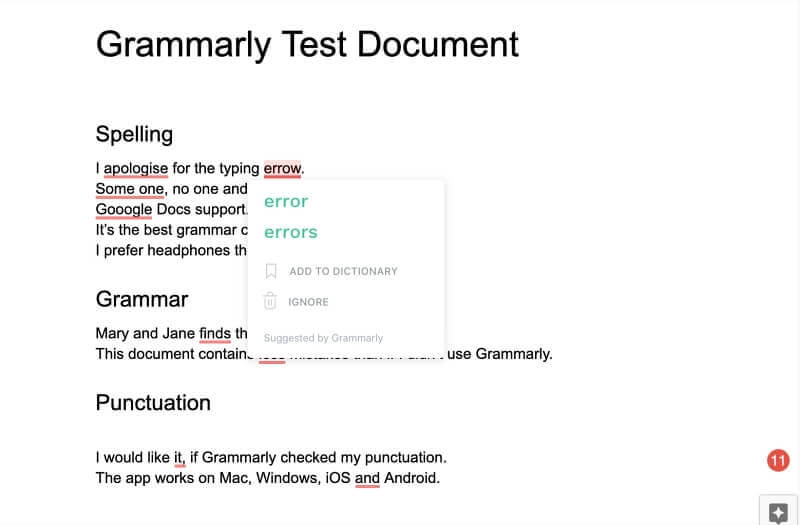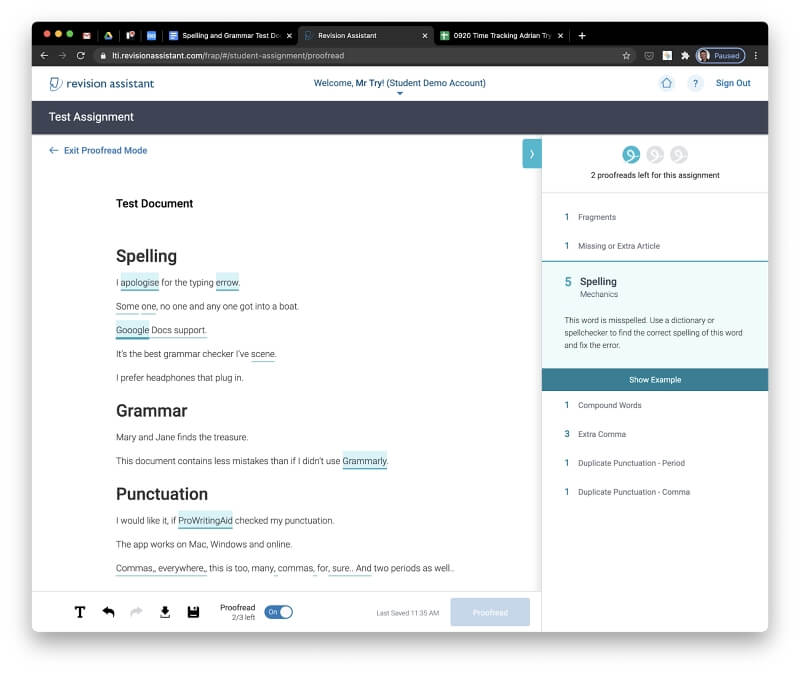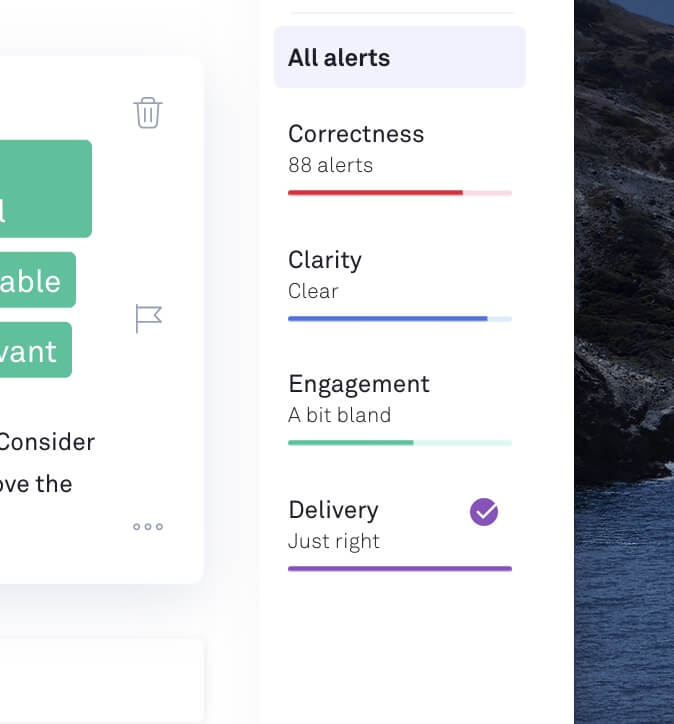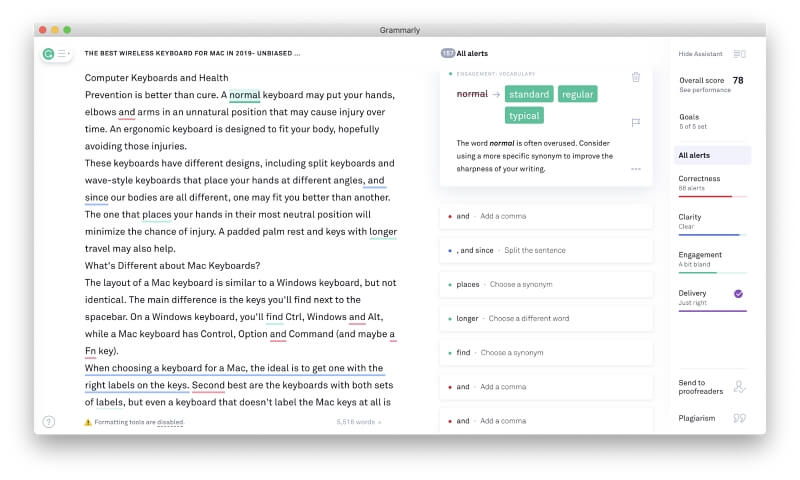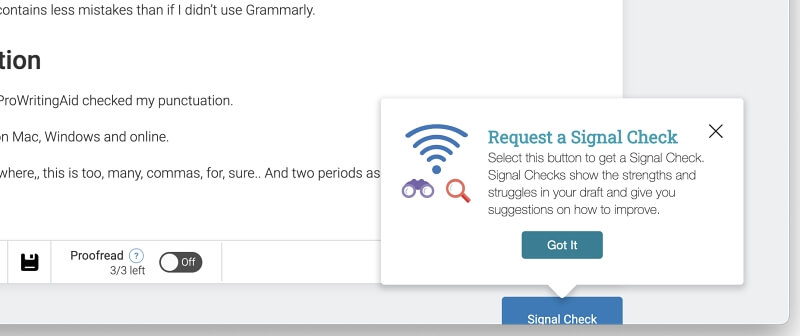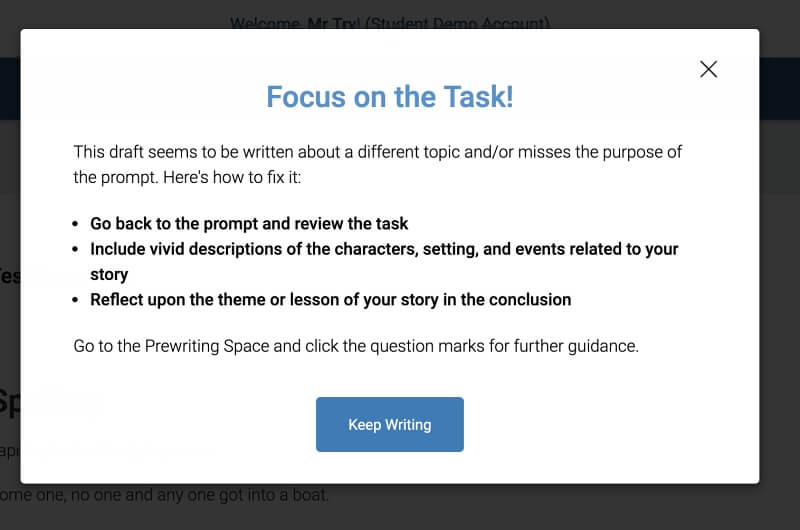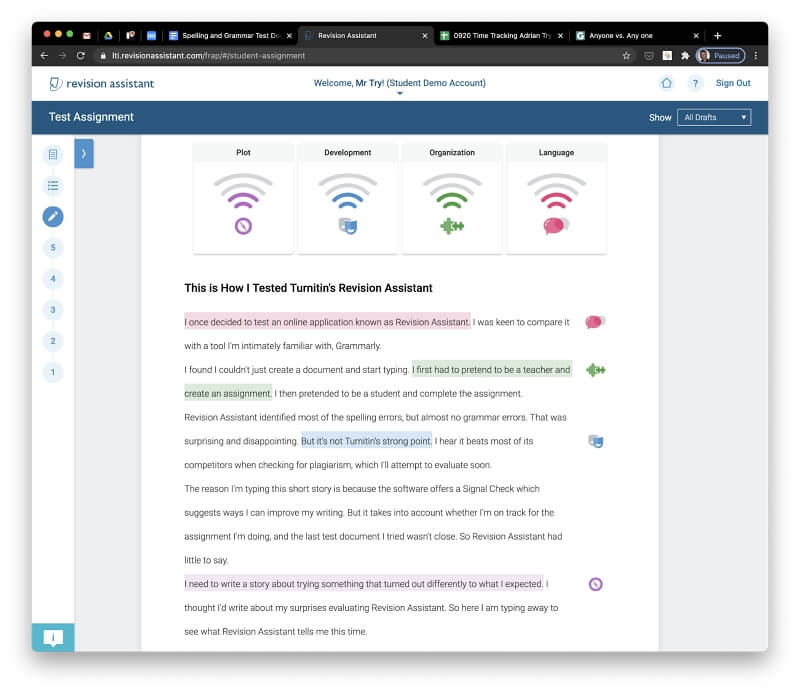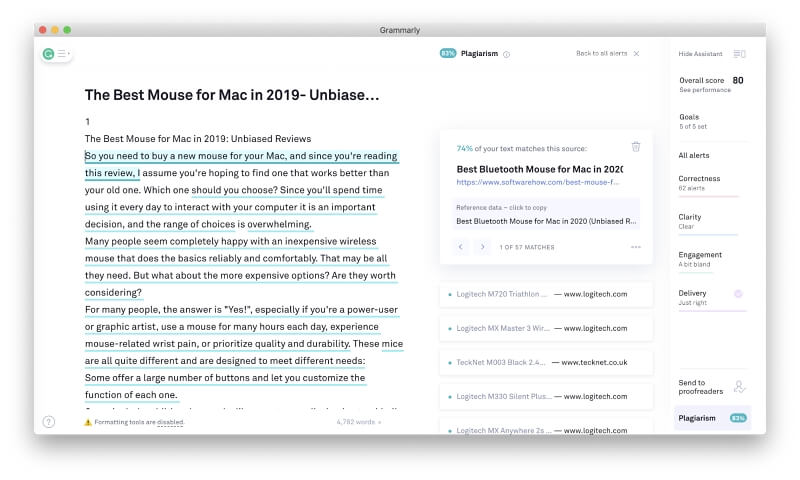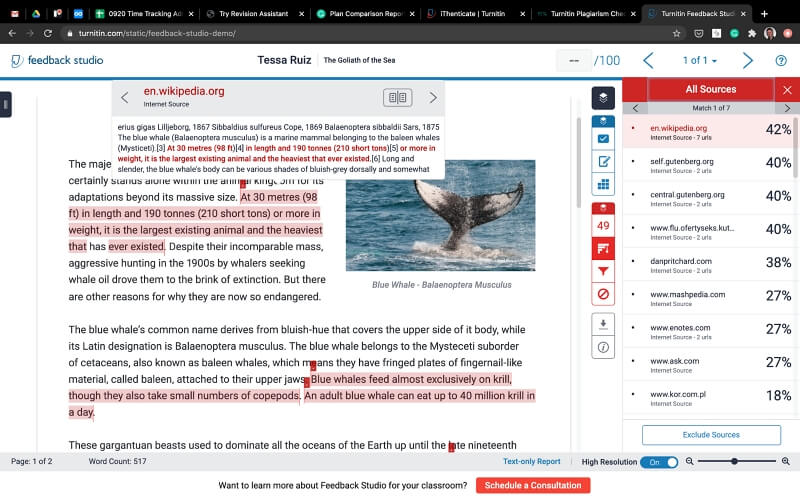Writers and students know they need to check their work before submitting it. Spelling and grammar errors must be found and corrected. What is written should be clear and accurate. Sources need to be correctly cited. Accidental plagiarism should be checked for.
In this article, we’ll compare two leading software solutions that do all of this and more.
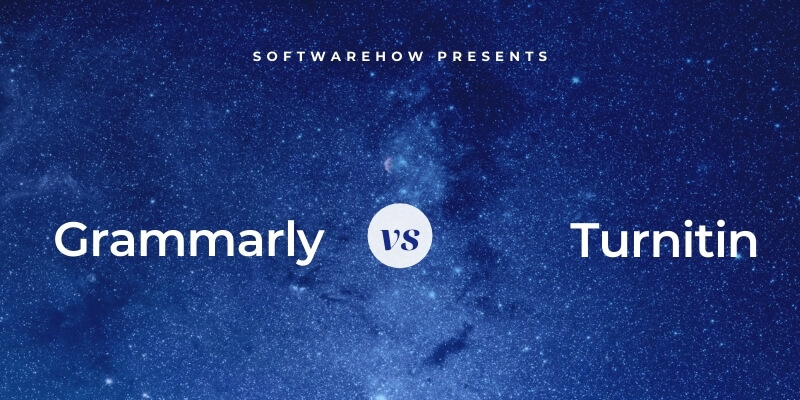
Grammarly is a popular and helpful program that will check your spelling and grammar for free. Its Premium version suggests how you can improve your writing’s readability and clarity and warns of potential copyright violations. We named it the best grammar checker and you can read the full review here.
Turnitin is a company that offers several products designed for the academic world, including best-in-class plagiarism checking. They help students when they write their papers. They help teachers who correct them. They provide an entire infrastructure for assigning and submitting work:
- Revision Assistant empowers students to “improve their writing with immediate, actionable feedback.” This feedback is relevant to the assignment at hand and is also available to teachers when checking papers.
- Feedback Studio offers similar tools with more functionality. A significant addition: it checks for “similarity” with sources on the web and in academia to identify potential plagiarism. It also tracks suspicious edits that may be trying to mask plagiarism.
- iThenticate unbundles the plagiarism checker from the educational software so that writers, editors, publishers, and researchers can take advantage of it outside of the classroom.
In many ways, these products are complementary. We’ll compare what they offer so that you can choose the one that suits you best.
If training and education are crucial for your business, Turnitin may be most suitable for you. Grammarly is a general tool that may better suit businesses and individuals outside of an educational context.
Table of Contents
Grammarly vs. Turnitin: How They Compare
1. Spell Check: Grammarly
I created a test document riddled with intentional spelling errors to test each app:
- “Errow,” an actual mistake
- “Apologise,” UK English instead of US
- “Some one,” “any one,” which should be one word instead of two
- “Scene,” a homophone for the correct word, “seen”
- “Gooogle,” a misspelling of a common proper noun
Grammarly’s free plan successfully identified every error. It has performed significantly better than every other grammar checker I tested.
To test Turnitin, I signed up for a 60-day free trial of Revision Assistant. I signed in as a teacher and created a class and assignment. Then, as a student, I pasted in the same test document as above.
I turned on Proofread mode, something students can only do only three times for each assignment. Turnitin correctly identified most of the errors. However, because it’s a tool for students, it didn’t suggest actual corrections. Instead, some general comments were made to point me in the right direction; the app recommended using a dictionary.
Only one spelling error was missed: “any one.” According to Grammar.com and other sources, it should be a single word in this sentence.
Turnitin doesn’t recognize proper nouns as intelligently as Grammarly does. It did underline the sentence containing “Gooogle” as an error, but not because it identified that the company name was misspelled. It also highlighted two other correctly spelled companies, “Grammarly” and “ProWritingAid” as errors.
Both apps can pick up spelling errors based on context. For example, you may have used an actual dictionary word in your paper, but used the wrong one for the sentence you are writing—”there” vs. “they’re,” etc.
Winner: Grammarly. It successfully identified every spelling error and suggested the correct spelling. Turnitin identified most errors but left it to me to determine how to correct them.
2. Grammar Check: Grammarly
My test document also included a ton of intentional grammar and punctuation errors:
- “Mary and Jane finds the treasure” contains a mismatch between the verb and subject
- “Less mistakes” uses an incorrect quantifier, and should be “fewer mistakes”
- “I would like it, if Grammarly checked” uses an unnecessary comma
- “Mac, Windows, iOS and Android” omits the “Oxford comma.” That’s a debatable error, but many style guides recommend its use
Grammarly’s free plan again successfully identified every error and suggested the right corrections.
Turnitin’s Revision Assistant attempts to identify grammar errors, but it had much less success than Grammarly. It flagged most of the extra commas and one of the double periods. However, it failed to flag one unneeded comma and a double period at the end of a sentence. Unfortunately, it also missed every other Grammar error.
Winner: Grammarly. Correcting grammar errors is its strongest feature; Turnitin doesn’t come close.
3. Writing Style Improvements: Grammarly
Both apps suggest how you can improve the clarity and readability of your writing. We’ve seen that Grammarly marks spelling and grammar errors in red. The Premium version uses blue underlines where clarity can be improved, green underlines where your writing could be clearer, and purple underlines where you can be more engaging.
I tested these features by signing up for a free trial of the Premium plan and having it check one of my articles. Here’s some of the feedback I received:
- “Important” is often overused. The word “essential” was suggested as an alternative.
- “Normal is also often overused, and “standard,” “regular,” and “typical” were offered as alternatives.
- “Rating” was used frequently throughout the article. It was suggested that words like “score” or “grade” could be used as alternatives.
- Many simplifications were suggested, such as when one word could be used instead of several. Where I used “on a daily basis,” I could have used “daily” instead.
- There were also warnings about long, complex sentences. Its feedback takes the intended audience into account; Grammarly suggested that I could split up several sentences so they could be more easily understood.
I found these warnings and suggestions helpful. I certainly wouldn’t make every change it suggested. However, being warned of complex sentences and repetitive words is valuable.
Turnitin also offers feedback and revision features. Their purpose is to keep students on track when completing assignments or show teachers where their students fell short. There is a Signal Check button at the bottom of the page that shows how a draft can be improved.
I evaluated that feature using the test document we used above in Revision Assistant. Because it didn’t answer the requirements of the assignment, though, its feedback was brief and to the point. Turnitin’s Signal Check is highly focused on the academic task being performed and isn’t as generally helpful as Grammarly is.
So I answered my homework question and tried again. Here’s the assignment I was meant to complete: “Expect the Unexpected: Tell a true story about something you did that produced an unexpected result. Describe the experience using specific details.” I wrote a brief story that answered the question and ran a second signal check. This time, the feedback was more helpful.
At the top of the screen, you will find four signal strength indicators that show how well you are doing with the assignment’s plot, development, organization, and language. Throughout the document, passages that can be improved are highlighted:
- The pink highlight is about language and style. Clicking on the icon gave me this feedback: “Your language in this sentence is helpful. Clearly establish the narrator of your story in the introduction. Maintain a consistent point of view by telling all events of the story from the narrator’s perspective.”
- The green highlight is about organization and sequencing. Clicking on the icon displayed: “Use appropriate transitions to clearly signal when events shift in time or place. Phrases like ‘later that day’ or ‘nearby’ help your readers understand when and where the action is taking place.”
- The blue highlight is about development and elaboration: “In the rising action of a story, the readers expect to learn how the central idea affects the main character. Provide detailed descriptions of how you or your main character navigates the events of the story.”
- The purple highlight is about plot and ideas: “The ideas in this section are showing strength. Review your narrative and be sure that you have completely explained to your readers how your story shows how something you did produced an unexpected result.”
While Grammarly offered concrete and specific suggestions, Turnitin’s comments are more general. It doesn’t aim to do the student’s homework for them. The feedback is relevant to the assignment I am doing. Grammarly’s feedback is relevant to the audience I am writing to.
Winner: Grammarly gave specific and helpful feedback on how I could improve my writing. Turnitin’s feedback is less useful but might be more suitable in the educational setting it’s designed for.
4. Plagiarism Check: Turnitin
Now we turn to Turnitin’s most powerful feature: plagiarism checking. Both apps check for potential plagiarism by comparing what you have written with a wide range of preexisting material on the web and elsewhere. Turnitin compares with many more sources and performs much more rigorous testing.
Here are the sources Grammarly checks:
- 16 billion web pages
- academic papers stored in ProQuest’s databases (the largest database of academic texts in the world)
Turnitin checks these sources:
- 70+ billion current and archived web pages
- 165 million journal articles and subscription content sources from ProQuest, CrossRef, CORE, Elsevier, IEEE,
- Springer Nature, Taylor & Francis Group, Wikipedia, Wiley-Blackwell
- Unpublished papers submitted by students using one of Turnitin’s products
I tested Grammarly Premium. It successfully identified seven instances of potential plagiarism and linked to the original source in each case.
Turnitin Feedback Studio includes a similarity check that identifies potential plagiarism. I couldn’t evaluate the app using my own test document, but I had a close look at Turnitin’s live online demo. It highlighted plagiarism in red and listed the original sources of the text in the left margin.
Turnitin iThenticate is a standalone service that can be used separately from Turnitin’s academic products, making it suitable for publishers, governments, admissions departments, and others.
Mohamed Abouzid is a user who performed plagiarism checks using products from both companies. In his experience, Turnitin is far more capable. He said a text found to be 3% plagiarized by Grammarly may be found 85% plagiarized with Turnitin.
Moreover, Turnitin isn’t fooled when minor changes have been made to copyrighted material. He explains how Turnitin performs more stringent tests than Grammarly:
Grammarly scans sentences, which means when you change one word, the sentence will pass the plagiarism test, but Turnitin scans each digit/letter/symbol. So, if you changed only one word in a sentence, the sentence will be marked as plagiarised while your word will not, which will be visible for the teacher that only one word has been changed. (Mohamed Abouzid on Quora)
Winner: Turnitin. It has a more extensive library from which to check for plagiarism. Its tests are harder to fool by tampering with the copied text.
5. Pricing & Value: Grammarly
Grammarly offers a generous free plan that detects spelling and grammar errors. Grammarly Premium suggests how to improve the readability of a document and identify potential copyright infringements. A Grammarly Premium subscription costs $29.95/month or $139.95/year. Discounts of 40% off or more are offered regularly.
Turnitin provides several subscription services, including Revision Assistant, Feedback Studio, and iThenticate. They prefer to sell directly to academic institutions. When they put quotes together, they consider the number of students an institution has and the features they need. Estimates of around $3 per student per year can be found online. No free plans are offered, but there is a free 60-day trial for Revision Assistant.
iThenticate can be used by buying credits without a subscription. However, they are expensive:
- $100 for a single manuscript up to 25,000 words in length
- $300 for one or more manuscripts up to 75,000 words combined
- Customized pricing options are available for organizations
Winner: Grammarly has a terrific free plan. It offers a cost and pricing model more suited to businesses and individuals. Academic institutions will be better suited to Turnitin’s features and hyper-accurate plagiarism detection.
Final Verdict
Most business users should use Grammarly. Its free plan reliably identifies spelling and grammar errors, while its Premium plan helps improve your writing and identifies potential copyright infringements.
If training and education are vital parts of your business, Turnitin’s products might be a better fit. They allow you to create student lists, set assignments, allow students to submit their work, and assist with marking.
Turnitin’s strongest feature is checking for plagiarism. When it comes to that, they’re the best in the business. Feedback Studio allows students and teachers to make sure that their work is original and that sources are correctly cited. iThenticate gives business users access to the same. Turnitin costs more than Grammarly, but you may find its greater accuracy worth it.

